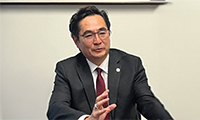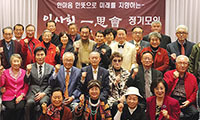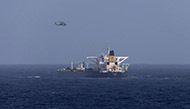TEHRAN, Iran
There were bright balloons at the 30th anniversary celebration of Iran’s Islamic revolution. Their vivid colors - blue, orange, yellow - shocked me. After two weeks here, I’d grown used to the swarms of women in black hijabs, the gray cars, the drabness offset only by the snowy peaks of the Alborz Mountains.
The revolution freed Iranians from the brutality of the shah’s secret police, the Savak, and delivered a homegrown society in place of one pliant to America’s whim. But like all revolutions, it has disappointed. Freedom has ebbed and flowed since 1979, but more often it has ebbed. Beneath the hijab, that is to say beneath the surface of things, frustrations multiply. Women sometimes raise their hands to their necks to express a feeling of suffocation.
Yet the revolution has survived. This strange attempt, in the 21st century, to regulate a society through the literal application of the tenets of Islam has proved more resilient than seemed possible three decades ago. An odd constitutional alchemy marrying elements of dictatorship and democracy has proved flexible enough, and ruthless enough, to accommodate, at a price, Iran’s development.
The message of an Islamic Iran has reverberated across the Muslim world, particularly in the Middle East, where the fight between Arabs and Israelis has in some ways broadened into a more intractable one between Islam and Zionism.
Iran has just fired a satellite into space. It is mastering the nuclear fuel cycle, to the West’s consternation, though it has no reactors to power. Nobody is expecting the revolution’s edifice to fall any time soon, certainly not before the conflict over the real purpose of that nuclear program comes either to military crisis or diplomatic resolution.
Revolutions - at least for young Iranians hooked on the Internet, blogs and cell phones - are yesterday’s story. Nobody will rise up. Modern technology provides repressive governments with a safety net: resentments seldom boil over because people feel just connected enough to cool rebellious adrenaline.
These are realities. It is time for the United States and the West to face them. I sometimes feel, when it comes to the Middle East, that“Green Zone politics”has infected the corridors of western power. The Green Zone in Baghdad is the walled fortress of an imaginary society that America created in Iraq as bloody mayhem prevailed outside. It no more reflected what Iraq is than Cleveland.
In the same way, America has tried to wish Hamas away and cause Hezbollah to disappear. It has also attempted to reduce Iran, a sophisticated society, to the axis-of-evil refuge of a bunch of crazy mullahs bent on nuking Israel.
Only when the West returns to dealing with the Middle East as it is, rather than as it dreams it might be, will the reduction of tensions become possible. That will also involve having the courage to see Israel for what it is: a nation that resorts too often to military force, as in Gaza, in a vain attempt to bend an ever better-informed Middle East to its will.
The other day, I asked Hussein Shariatmadari, the editor of the pro-government Kayhan newspaper, whether Iran had links to terrorist organizations.“If we had any links to the United States,”he shot back,“we could claim that we were linked to the largest terrorist organization in the world.”
I know, braggadocio, but after the Bush years, not an uncommon form of it in the Middle East. It’s time for a reality check. The West has been chasing bright balloons of illusion across this region. They will lead nowhere.
스마터리빙
more [ 건강]
[ 건강]이제 혈관 건강도 챙기자!
[현대해운]우리 눈에 보이지 않기 때문에 혈관 건강을 챙기는 것은 결코 쉽지 않은데요. 여러분은 혈관 건강을 유지하기 위해 어떤 노력을 하시나요?
 [ 건강]
[ 건강]내 몸이 건강해지는 과일궁합
 [ 라이프]
[ 라이프]벌레야 물럿거라! 천연 해충제 만들기
 [ 건강]
[ 건강]혈압 낮추는데 좋은 식품
[현대해운]혈관 건강은 주로 노화가 진행되면서 지켜야 할 문제라고 인식되어 왔습니다. 최근 생활 패턴과 식생활의 변화로 혈관의 노화 진행이 빨라지고
사람·사람들
more
[인터뷰-문경환 한인회장] “캔자스, 이민자들에 제2의 기회의 땅”
“캔자스시티는 삶의 속도와 기회의 균형이 잘 맞는 도시입니다. 제2의 인생을 시작하기에 더없이 좋은 곳이죠.”29일 본보를 방문한 문경환(61…

일사회 창립 14주년 기념식 및 송년행사
전·현직 민주평통자문위원들의 모임인 일사회(회장 박철웅)는 지난 16일 용수산에서 창립 14주년 기념식 및 송년회를 개최했다. 이날 행사에는 …
LA평통 통일전략분과 상견례
LA 평통(회장 장병우) 통일전략분과(위원장 이정현)는 지난 27일 형제갈비에서 상견례 겸 간담회를 개최했다. 이날 모임에서는 위원 간 교류를…
새해 ‘사랑의 쌀’ 나눔 내달 10일 교협 강당
남가주기독교교회협의회(회장 김재율 목사·이하 교협)가 새해를 맞아 ‘새해 오찬기도회 및 사랑의 쌀 나눔’ 행사를 개최한다. 행사는 오는 1월1…
[송년 행사] 이승만 기념사업회
이승만 건국대통령 기념사업회(회장 박요한)가 지난 18일 시티 뱅큇 홀에서 송년회를 개최했다. 이날 행사에서는 장혜숙, 장준구, 이형숙, 이하…
많이 본 기사
- 트럼프 만나고온 젤렌스키 “우크라에 미군 주둔 방안 논의중”
- 폭설 속 산행 비극… 마운트 볼디서 3명 조난 사망
- 가주 판매 간 소고기 ‘이콜라이’ 오염
- 한국팀 뛸 곳인데… 강력범죄 ‘충격’
- ‘아듀~ 2025!’… 희망찬 새해로
- [알림] 오늘 신년특집 발행
- [LA 일원 새해맞이 명소는] “웰컴 2026”… 남가주 새해맞이 행사 풍성
- LA 북쪽 테혼 카지노서 하룻새 10만불 ‘연속 잭팟’
- 소프트뱅크, 오픈AI에 410억달러 투자 완료…11% 지분 확보
- “10년간 모든 이민 전면 금지?” 황당 주장
- 이란, 트럼프-네타냐후 회담 직후 “당신들은 우리 못 꺾소”
- 신년 연휴 폭풍우… 비 3인치 온다
- ‘백두산 호랑이’ 대가족 포착… “매우 희귀한 일”
- 새해 미국 건국 250주년… ‘트럼피즘’ 도전장 받은 민주공화정
- [연말 기획] 한국계 혼혈들 두각… 각 분야에서 ‘맹활약’
- 구리선 절도범 소행에 LA 교통 통신망 ‘먹통’
- ‘케네디’가 또 비극 외손녀 희귀암 별세
- 디즈니 ‘유튜브에 아동정보 무단제공’ 1천만 달러 과징금 확정
- [연말 화제] 올해도 찾아온 ‘얼굴 없는 천사’
- [인터뷰-문경환 한인회장] “캔자스, 이민자들에 제2의 기회의 땅”
- 목표는 1,000골… 불혹 호날두 “부상 없다면 가능”
- 동포청 ‘재외동포 이해교육’ 실시
- “치매에 치즈가 좋대서 맨날 먹었는데”… 고지방 주의
- 원·달러 환율… 연평균 기준 ‘역대최고’ 마감
- 트럼프 “베네수엘라 마약 싣는 항만 타격”… 첫 지상 공격
- [한인 은행장 신년사 통해 본 비전과 경영 목표] “끊임없는 변화와 혁신으로 안정적 성장 도모”
- 이강인 뛰는 PSG, ‘2025 최고의 팀’
- 우크라 ‘푸틴 관저 공격설’에 종전 기대감 찬물
- [경제 트렌드] AI 열풍 속에 신흥 2030 억만장자 급증
- 샴페인, 마지막 날과 첫날을 위하여
- 케이스쉴러 주택가격지수 상승
- 트럼프 이름 덧붙인 ‘케네디센터’ 공연 줄취소
- ‘헤비급 복서’ 조슈아 구사일생 동승자 2명 사망사고에도 경상
- SI “김하성 영입은 A-” 수비력 유지·공격력 향상
- 요키치 부상… 덴버, 마이애미에 덜미
- [조지 F. 윌 칼럼] 저무는 2025년에 안도의 한숨
- [만화경] 경영자의 ‘문제적’ 사과
- 기아, 타임스퀘어 새해 전야 참여
- 사실상 고객 1인당 1만원… “생색내기 보상으로 불신만 키워”
- 오픈AI에 400억불 투자 소프트뱅크가 10% 지분
- 연방정부, 기업 채용·승진정책 조사
- 인디브랜드가 이끈 K뷰티… 패션도 유럽 본고장 깃발
- [수요 에세이] 다시, 제자리로 돌아와서
- “경기 둔화·샤핑패턴 변화 파고 못 넘어”
- 중국, 올해 신차판매 1위… 일본 ‘20년 아성’ 깼다
- 정부 “KT 침해사고 과실 인정… 위약금 면제해야”
- 삼성·SK 중 반도체공장 장비규제 완화
- SNS, 뉴스 매체로도 인기 틱톡·유튜브·페이스북 등
- 메타, ‘제2의 딥시크’ 마누스 인수
- 단백질 늘리고 탄수화물 줄이고…영양소 적정 기준 개정
1/5지식톡

-
 미 육군 사관학교 West Poin…
0
미 육군 사관학교 West Poin…
0https://youtu.be/SxD8cEhNV6Q연락처:wpkapca@gmail.comJohn Choi: 714-716-6414West Point 합격증을 받으셨나요?미 육군사관학교 West Point 학부모 모…
-
 ☝️해외에서도 가능한 한국어 선생님…
0
☝️해외에서도 가능한 한국어 선생님…
0이 영상 하나면 충분합니다!♥️상담신청문의♥️☝️ 문의 폭주로 '선착순 상담'만 진행합니다.☎️ : 02-6213-9094✨카카오톡ID : @GOODEDU77 (@골뱅이 꼭 붙여주셔야합니다…
-
 테슬라 자동차 시트커버 장착
0
테슬라 자동차 시트커버 장착
0테슬라 시트커버, 사놓고 아직 못 씌우셨죠?장착이 생각보다 쉽지 않습니다.20년 경력 전문가에게 맡기세요 — 깔끔하고 딱 맞게 장착해드립니다!장착비용:앞좌석: $40뒷좌석: $60앞·뒷좌석 …
-
 식당용 부탄가스
0
식당용 부탄가스
0식당용 부탄가스 홀세일 합니다 로스앤젤레스 다운타운 픽업 가능 안녕 하세요?강아지 & 고양이 모든 애완동물 / 반려동물 식품 & 모든 애완동물/반려동물 관련 제품들 전문적으로 홀세일/취급하는 회사 입니다 100% …
-
 ACSL 국제 컴퓨터 과학 대회, …
0
ACSL 국제 컴퓨터 과학 대회, …
0웹사이트 : www.eduspot.co.kr 카카오톡 상담하기 : https://pf.kakao.com/_BEQWxb블로그 : https://blog.naver.com/eduspotmain안녕하세요, 에듀스팟입니다…
케이타운 1번가
오피니언
 정숙희 논설위원
정숙희 논설위원샴페인, 마지막 날과 첫날을 위하여
 조지 F·윌 워싱턴포스트 칼럼니스트
조지 F·윌 워싱턴포스트 칼럼니스트 [조지 F. 윌 칼럼] 저무는 2025년에 안도의 한숨
 김동찬 시민참여센터 대표
김동찬 시민참여센터 대표 [미국은 지금] 책임 있는 자본 없으면 커뮤니티 미래도 없다
 성영라 수필가 미주문협 부이사장
성영라 수필가 미주문협 부이사장 [수요 에세이] 다시, 제자리로 돌아와서
 신경립 / 서울경제 논설위원
신경립 / 서울경제 논설위원 [만화경] 경영자의 ‘문제적’ 사과
 문태기 OC지국장
문태기 OC지국장 한인 정치력 업그레이드 기대
 민경훈 논설위원
민경훈 논설위원세계 역사를 바꾼 동물
 박홍용 경제부 차장
박홍용 경제부 차장 한인사회가 주목해야 할 새해 경제
 박영실 시인·수필가
박영실 시인·수필가 [화요칼럼] 피드백
1/3지사별 뉴스

메트로카드, 31년만에 역사 속으로
1994년 처음 등장해 지난 31년간 뉴욕시 전철과 버스 승차권으로 쓰인 메트로카드가 31일을 끝으로 역사 속으로 사라진다. 더 이상 메트로카…
■ 사고- 한동대·뉴욕한인청소년센터 국제여름캠프

2025 워싱턴지역 10대 뉴스
다사다난했던 2025년이 하루만 남겨둔 채 역사의 저편으로 저물고 있다. 올해의 가장 큰 뉴스는 트럼프 2기 행정부 출범과 함께 몰아친 이민 …
내년 1월부터 달라지는 MD 법안들

셀폰 위치추적, 납치된 딸 살렸다… ‘부모 통제’ 기능 활용
스마트폰에서 자녀의 위치를 확인할 수 있는 ‘부모 통제(parent control)’ 위치 추적 기능의 도움으로 납치됐던 청소년들이 잇달아 구…
[새해부터 이렇게 달라진다] 최저임금 또 오르고… 유급 병가는 더 확대

오늘 하루 이 창 열지 않음 닫기 


















































.png)


댓글 안에 당신의 성숙함도 담아 주세요.
'오늘의 한마디'는 기사에 대하여 자신의 생각을 말하고 남의 생각을 들으며 서로 다양한 의견을 나누는 공간입니다. 그러나 간혹 불건전한 내용을 올리시는 분들이 계셔서 건전한 인터넷문화 정착을 위해 아래와 같은 운영원칙을 적용합니다.
자체 모니터링을 통해 아래에 해당하는 내용이 포함된 댓글이 발견되면 예고없이 삭제 조치를 하겠습니다.
불건전한 댓글을 올리거나, 이름에 비속어 및 상대방의 불쾌감을 주는 단어를 사용, 유명인 또는 특정 일반인을 사칭하는 경우 이용에 대한 차단 제재를 받을 수 있습니다. 차단될 경우, 일주일간 댓글을 달수 없게 됩니다.
명예훼손, 개인정보 유출, 욕설 등 법률에 위반되는 댓글은 관계 법령에 의거 민형사상 처벌을 받을 수 있으니 이용에 주의를 부탁드립니다.
Close
x